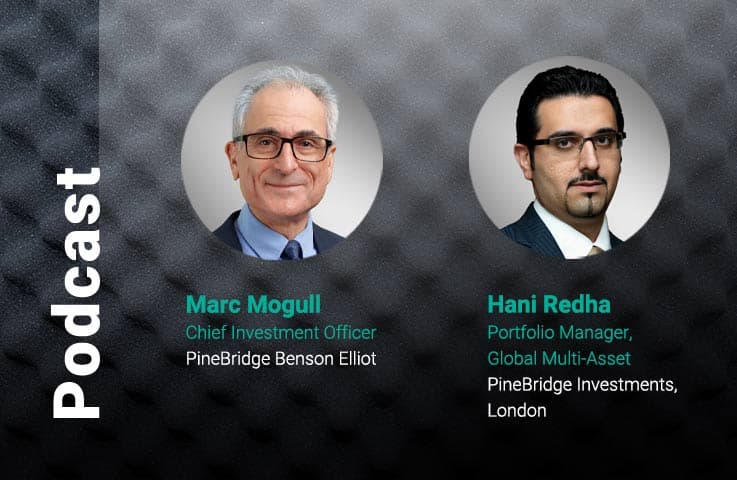Why European Commercial Real Estate Could Be a Buyer’s Market in 2023 – For Those Willing to Wait

In commercial real estate (CRE), a “bad” market is always a matter of perspective. How one views declining real estate values depends entirely on whether one is a seller or buyer, the party under pressure to exit a distressed property, or the party viewing the situation from the opposite vantage point – armed with a healthy supply of dry powder. For those wondering whether the recent decline in European CRE prices will turn into a dry powder market in 2023, we believe the answer is “Yes, likely so,” says Marc Mogull, Chairman and Chief Investment Officer of London-based PineBridge Benson Elliot. But that comes with a caveat: “You need to be patient,” he says.
Eyes on the banks
Mogull bases his assessment of timing simply on how long it takes for the deteriorating fundamentals of a property to register with its lender and for a lender to set the wheels in motion that can eventually lead to a property being listed for sale.
Macroeconomic conditions have certainly done their part to set the stage. When inflation spiked to 7% in November 2021 and the Bank of England (BoE) embarked on the start of what would become 10 straight increases in its base interest rate,1 it knew full well that two major consequences of its inflation-fighting actions would be a slowing of economic activity and a significant sell-off in risk-based assets – and that both would likely wallop commercial real estate. And, indeed, that is exactly what happened. UK commercial property values fell 13.9% in 2022, completely wiping out 2021’s gains, according to the CBRE Monthly Index. Industrial properties were down a whopping 21%.2 On the Continent, the value of CRE transactions in the third quarter of 2022 plummeted 37% year over year.3
Still, property owners’ 2022 year-end valuation reports aren’t due to their lenders until March or April 2023, at which point it will still take time to enforce covenants that push an owner into a sale or for foreclosures to play out. “Factor in a reasonable period for banks to reflect and recalculate, and we should only expect to see a determined upswing in product hitting the market as summer gives way to fall,” Mogull says.
Rest assured, though, that upswing is coming, he predicts. And, the good news (if you’re a buyer) is that a surprising portion of the pickings could be quite prime.
Playing the (capital charge) slots
In looking ahead to how distress in the European CRE market could filter through to bargains by late 2023, Mogull says investors need to consider some of the other factors that will be weighing on bankers’ thinking by then. And, also, how much those factors have changed since the last time commercial real estate came in for a significant re-rating.
Many investors will recall how in the wake of the global financial crisis (GFC), many lenders allowed their customers to hang on to properties for months or even years after they fell into arrears in the faint hope (or fantasy) that the loans would eventually get repaid. But, back then, the loan to value ratios (LTVs) of distressed properties were so high that “extend and pretend” made sense, in a way. Today, LTVs are much lower. That means even with the rather steep falls in assumed asset values, most bank loans secured by property today are still recoverable through a sale, providing lenders much more motivation to get on with it. Remember, too, that after the GFC, interest rates plunged to zero (and even below that in the eurozone). As a result, opportunity costs were essentially nonexistent, allowing banks to justify carrying loans and properties indefinitely as they hoped for recovery (i.e., “delay and pray”). With the UK prime lending rate having recently eclipsed 3.5%, and more rises likely in store, that’s clearly not the situation today.
Meanwhile, regulatory changes implemented over the past dozen years require today’s lenders to treat the loans on their books very differently than they did prior to and immediately after the GFC. Now, every appreciable decline in the quality of a loan comes with a higher capital charge, which, in turn, negatively impacts a bank’s return on equity. How negatively? “Quite a lot, actually,” says Mogull. The current banking framework, he explains, guides banks to categorize CRE loans into one of five slots – strong, good, satisfactory, weak, or default – each corresponding to a different capital charge. For example, a Category 1 (strong) loan with a remaining maturity of less than 2½ years can receive a preferential risk weighting of just 50%, but if that same loan gets re-slotted as Category 4 (weak), it will be risk-weighted at 250%. Ouch.
In a market where the most invested sectors, legacy office and retail, are seeing steadily weakening tenant demand, falling rents, and rising energy and refinancing costs, the stricter rating standards of today’s regulatory framework mean that even many decent-quality properties are about to become a major liability for their lenders. “I wouldn’t want to be the CRE head in a bank trying to argue the Category 1 case with my banking supervisor,” Mogull says. “But then, I wouldn’t want to be that same CRE head explaining to my CFO why I needed five times more capital allocated to my division, without the prospect of higher profits.”
Getting a better sense of the picture now?
One man’s pressure …
Of course, pressure experienced in one part of the market can be an opportunity for others. For all the duress banks may be under to move product come the latter months of this year, Mogull doesn’t believe the dynamics will devolve into what he would call a “disorderly market.” Banks, after all, are much better capitalized than they were post-GFC, and on the other side of the table are ample supplies of dry powder to strike reasonable deals. The list of buyers with such hoards is not long, mind you – not with REITs hobbled by share prices trading below their net asset values, overseas investors still spooked by the war in Ukraine, and various challenges sidelining other segments of market participants. But such demand constraints, too, are a positive for those relative few in a position to pounce. “These will certainly be results-driven processes, creating an attractive buying opportunity,” Mogull says.
Yet this is where other caveats also come into play. As Mogull notes, Europe remains a market where the right kind of prime real estate will always find a buyer (and tenant), but where secondary properties can be painfully hard to move. While some assets will trade at what seem like very compelling valuations, taking advantage of the coming distress “isn’t going to be about buying someone else’s garbage,” he says. It will be about remaining laser-focused on those properties with predictable cash flow streams, strong market fundamentals, even stronger locational advantages, and resistance to obsolescence, particularly in terms of what passes muster as “green.” Absent that? Just wait.
1 Data as of December 2021. Source: CNBC 2 Data as of January 2023. Source: Reuters 3 Data as of October 2022. Source: CRE Herald
This material was prepared by PineBridge Benson Elliot for educational purposes only. The information contained herein may not be replicated, reproduced, distributed or provided to any other party without the prior written consent of PineBridge Investments. Opinions expressed herein are solely those of investment manager and may differ from the views or opinions expressed by other areas of PineBridge Investments. This material is for informational purposes only and does not constitute: (i) research or a product of any research department, (ii) an offer to sell, a solicitation of an offer to buy, or a recommendation for any investment product or strategy, or (iii) any investment, legal or tax advice. Any opinions, projects, forecasts and forward looking statements contained herein are speculative in nature, valid only as of the date hereof and subject to change. All investment strategies involve risks, there can be no assurance that the investment objectives of any particular strategy will be met in any particular circumstances. All information has been obtained from sources believed to be reliable, but its accuracy is not guaranteed and no independent verification of the information has been obtained. See Global Disclosure Statement for more information.



